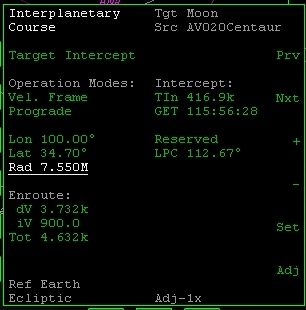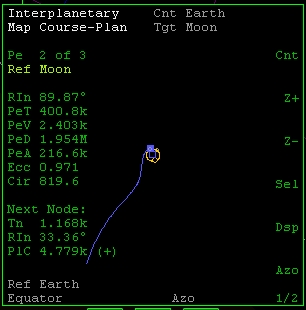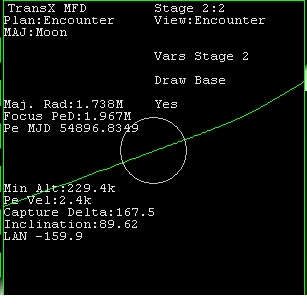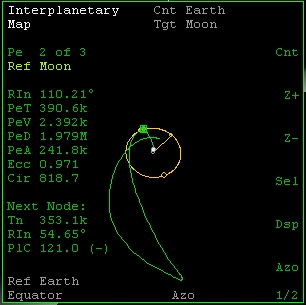Lunar Reconnaissance Orbiter (BrianJ add-on)
Overview
The Lunar Reconnaissance Orbiter (LRO) is the first mission in NASA's planned return to the moon. LRO will launch 2nd March, 2009, with the objectives to finding safe landing sites, locate potential resources, characterize the radiation environment and test new technology.
The return to the moon will enable the pursuit of scientific activities that address our fundamental questions about the history of Earth, the solar system and the universe -- and about our place in them. It will allow us to test technologies, systems, flight operation and exploration techniques to reduce the risk and increase the productivity of future missions to Mars and beyond. It will also expand Earth's economic sphere to conduct lunar activities with benefits to life on our home planet.
LRO is an unmanned mission to create the comprehensive atlas of the moon's features and resources necessary to design and build a lunar outpost. LRO focuses on the selection of safe landing sites, identification of lunar resources and the study of how lunar radiation will affect humans.
After launch, the LCROSS shepherding spacecraft and the Atlas V’s Centaur upper stage rocket will execute a fly-by of the moon and enter into an elongated Earth orbit to position LCROSS for impact on a lunar pole. On final approach, the shepherding spacecraft and Centaur will separate. The Centaur will act as a heavy impactor to create a debris plume that will rise above the lunar surface. Following four minutes behind, the shepherding spacecraft will fly through the debris plume, collecting and relaying data back to Earth before impacting the lunar surface and creating a second debris plume.
The debris plumes are expected to be visible from Earth- and space-based telescopes 10-to-12 inches and larger.
This is a difficult and challenging mission. Experienced orbinauts will enjoy the challenge of targeting the LCROSS to impact the North Pole of the moon, when the LRO spacecraft is overhead. This mission is not recommended for people recently starting to use Orbiter. Familiarity with setting up gravity assist maneuvers in TransX is a required skill.
Mission Objectives
LRO
The objective of the LRO mission is to map the lunar surface in preparation for the return of human missions to the moon, which are planned to occur by 2020.
LCROSS
Earth’s closest neighbor is holding a secret. In 1999, hints of that secret were revealed in the form of concentrated hydrogen signatures detected in permanently shadowed craters at the lunar poles by NASA’s Lunar Prospector. These readings may be an indication of lunar water and could have far-reaching implications as humans expand exploration past low-Earth orbit. The Lunar CRater Observing and Sensing Satellite (LCROSS) mission is seeking a definitive answer.
required add-ons
- Atlas V heavy V2 by Kev33
- IMFD 5.1m
optional add-ons
Spacecraft Specifications
Spacecraft Controls
Procedures
Accuracy of burns in this mission is CRITICAL. During this mission, especially after the TLI burn, we will be using the tools TransX or IMFD to get the DIRECTION of our burns, and using IMFD map to monitor in real time the MAGNITUDE of the DeltaV we are imparting. For this mission, usually the AUTOBURN button is NOT your friend.
The precession of the Moon's axis is not modelled in Orbiter. You may wish to edit your config/Moon.cfg file and change the LAN and SidRotOffset lines to
SidRotOffset = -4.52701 LAN = 5.2775
This will ensure a more accurate orientation of the Moon for the LRO simulation.
Launch
Fire up the 01 - AV020 LRO launch scenario in the LRO scenarios folder This is a night launch so visibility is poor until after the TLI burn. The scenario starts at UTC 03/02/2009 05:25:00. Launch time is UTC 05:26:27. The default camera view is Ground Observer. You have just over a minute to set up the camera to your personal preference.
At UTC 05:26:17 press the p key to start the launch countdown and 1st stage auto-pilot.
At T-5 seconds, engine ignition will happen, and the hold down clamps release at T-0. The Atlas V-401 1st stage autopilot will continue until 1st stage seperation.It can be disengaged by Pressing p again, but this is not recommended.
10 seconds after 1st stage separation, press the p key again.
This will ignite the 2nd stage Centaur engine, and engage the 2nd stage autopilot which will put the vehicle in a circular 185km parking orbit. Pressing p again will disengage the 2nd stage autopilot.
Shortly after 2nd stage ignition, the fairing will be automatically jettisoned, and the LRO/LCROSS spacecraft will be exposed.
TLI
After SECO, while established in the 185km parking orbit, set the Left MFD to IMFD.
Also, click the HUD button in the right orbit MFD so that your HUD is set to orbit reference Earth
IMFD Configuration set-up
Click MNU, then Configuration. Click Nxt, then + to change the Mission timer to MJD mode. Click Nxt ten times to hightlight Parking Orbit Alt. Click Set, and set this to 185k
Establishing the TLI burn
Click MNU, then Course. Target Intercept should be highlighted. If not, click Nxt until it is. Click Set Click Tgt and enter Moon Click Nxt 5 times so that Realtime is highlighted. Click + to change it to Off-Axis. Click Nxt until the Tej parameter is highlighbted. Click + or - repeately until the dV parameter reaches a minimum. This should be about 3.59k
Select IMFD in the right MFD also.
Click MNU, then PG. Enter 0 for the MFD ID. Click Map. Click Tgt, and enter Moon. Click PG, then Plan. Clidk PG, then click Sel until Ref Moon appears in yellow text.
In the left MFD, Click MOD, and Offset Disabled should be highlighted. Click + twice and Vel. Frame should be displayed. Click Nxt until Lon is highlighted. Click Set and enter 100. Click Nxt and Lat should be highlighted. Click Set and enter 35.9. Click Nxt, then Set, and enter 7.28M for Rad. Adjust the Rad and Lat parameters to get the PeA and Rin parameters in the right MFD as close as possible to 216k and 90 degrees. Repeat as necessary. Click Pg, then BV, then AB.
Sit back and wait for the burn. You may wish to use time acceleration to get close to the burn time, but set it back to 1x acceleration once you get close.
When the TLI burn is complete, click on the BV button to restore the main IMFD Course target intercept screen
Do not jettison LRO yet
Lunar targeting/LRO
When you reach 32M altitude above the Earth, the Centaur engine will automatically purge of all fuel and control switches over to the LCROSS propulsion system. You may initate the engine purge manually by pressing B. It is critical that you get your targeting done for both LRO and LCROSS before this time, as once that happens, your deltaV budget is severely limited.
At about 21M altitude above the earth, select TransX in the Right MFD.
Click on the -- button until the target is Moon Click VW once so the View is Manoevre
Select TransX also in the Left MFD.
In the Left MFD click FWD, then VW, so that the view is 'Encounter' In the Right MFD click ++ so Manoevre mode is On Click VAR 5 times so that Ch. Plane vel. is displayed Click ADJ so that Medium adjustment mode is entered. Click -- until the Min Alt. parameter in the Left MFD is over 216k
Our goal here is to end up with an Inclination parameter in the left MFD as close as possible to 90 degrees, and the Min Alt. parameter as close as possible to 216k.
In the Right MFD click VAR 3 times so that Prograde Vel is selected. Click on ADJ 3 times for Super adjustment mode. Click on ++ or -- until Min Alt. is close to 216k and Inclination is close to 90 degrees in the Left MFD.
Keep repeating these adjustments, using finer adjustment modes until you get as close as possible to the required parameters. Work quickly though, as the orbital debris is getting closer and we still have to target the LCROSS spacecraft.
In the Right MFD click VW to get Target view Use rotation mode to get the cross as close as possible to the center of the target. Do NOT make the burn yet
Use the planetarium view F9 key to make sure you are pointed in a generally northerly direction (towards Polaris + or - 30 degrees or so) If you are pointed in a southerly direction, the transx targeting will have to be re-done using ++ Ch. plane vel. instead of --
Set the Left MFD to IMFD.
Press the MNU button and select Map mode. Press the TGT button and enter Moon Press the Sel button until Ref Moon is displayed.
Watch the PeA parameter as you make a low dV burn with the Centaur engine Ctrl-numpad + When the Pea gets to +216k, STOP the burn with the numpad * key. As it gets close you may with to use translation mode and the numpad-6 key. There is no reverse translation. Don't overshoot by very much, if at all. Some dV will be added by LRO jettison which we will have to correct later.
Press the j key to jettison LRO.
On the Right MFD click VW twice to get back to Maneuver view Click VAR until Maneuver Mode is displayed. Click ++ to turn Maneuver mode Off
Lunar targeting/LCROSS
- Swingby of moon is passive (no thrusting)
- 81 days in post-swingby cruise orbit
- Current baseline is 3-month trajectory with south pole impact
- Two revolutions in high ecliptic inclination (~50 deg), 40-day period Earth orbit
After the LRO is jettisoned, swing the Centaur around 180 degrees. Use the finely graduated scale on the hud, or Attitude MFD to do this. When the Centaur is pointed 180 degrees from where it was when you made the LRO targeting burn, make another small burn, again watching IMFD map so that the final PeA is about 2M on the opposite side of the moon. Select IMFD on the right MFD
Click MNU, then Course. Click NXT 4 times so that Delta Velocity is highlighted. Click Set. Click on TGT and enter Moon as the target. Click Nxt 5 times so that dVf is highlighted. Click Set and enter 0.
In the Left MFD click PG then Plan. The green line of our orbit should turn blue. In the Right MFD click + repeatedly. The RIn parameter in the Left MFD should increase. If not, Click - until it does. Also watch the PeA parameter. Do not let it go negative.
When PeA gets too low, click Nxt on the Right MFD so that dVp is highlighted. Click - until PeA in the Left MFD is back to around 2M. Setting Adj to 10x may be necessary, but return it to 1x when finished.
Keep repeating these adjustments until Rin is close to 90 degrees and PeA is close to 2M. This is just a ball bark "rough in" to make our transx tageting easier. The numbers do not have to be exact. Work quickly though. Liberal use of the Pause function is encouraged.
In the Right MFD, click Pg, then BV.
Use rotation mode to align the cross in the center of the target and then select translation mode and use CTRL-numpad + to burn until BT is close to 0. AutoBurn is not recommended.
Once this is done, in the Left MFD click PG, then Plan, so the orbit line turns green again.
Select Transx in both MFD's.Select moon as the target in the right MFD, as in the LRO targeting.
Click the FWD button for stage 2, make sure the view is Setup and select the target as Escape. Click the FWD button again for stage 3, and select the target as Moon Click the VW button for Sling Direct view. On the Left MFD, click the FWD button for stage 2, if not already there. Click the VW button for slingshot view, if not already there.
There will be a green line extending from the center of the moon to hopefully past the edge. This is an edge-on view of our current approach to the moon. We need to fine tune this approach to give us a lunar gravity assist which will result in a highly inclined orbit around the earth with a period of 40 days
On the Right MFD, click the VAR button twice to bring up the Inc. angle parameter Click on -- several times until the dotted yellow orbit is about the same size as the solid green line. It does not have to be superimposed in the same place, but of a similar diameter.
On the Left MFD the dotted yellow line should be on the same side (more or less) of the moon as the green line. If it is on the opposite side, click on the ++ button until it is on the same side.
On the Right MFD, click on VAR four times until the outward angle parameter is shown. Adjust this parameter, and the Inc. angle parameter until the dotted line is superimposed on the solid green line in the slingshot view.
This is our current trajectory. Now we need to adjust the trajectory to impact the moon in 2 orbits with a 40 day period.
On the Right MFD, click VW so that the setup view is shown Click VAR 3 times so that Orbits to Icept is shown Click ++ 4 times so that the Orbits to Icept parameter is 2.0
Now we must figure out what our Enc. MJD should be. Take the current MJD and add 85 to it. (5 days to reach the moon, then 2 orbits of 40 days each.) For the Feb 28 (UTC) launch this would be 54890 + 85 = 54975. This is the Enc. MJD we will be shooting for.
Click VW again in the right MFD to get back to sling direct view. Adjust the Inc Angle to get as close as possible to the desired MJD. Click VAR so that Outward angle is displayed. Click ADJ twice so that the increment is Fine Adjust Outward angle to get the Cl. App. as close as possible.
My current solution is Inc Angle of -115.18 degrees and Outward angle of -47.54. Enc MJD is 54978.5013, and Cl. App is 1.747M
Your Mileage may vary.
Once a solution has been reached, click BCK twice on the Right MFD. The View should be Maneuver and Maneuver mode should be off. Click ++ to turn Maneuver mode on Adjust Prograde Vel. and Ch. Plane vel. until the dotted yellow line on the Left MFD lines up with the solid green line. R. Inc should be as close as possible to 0, and Pe Ratio should be as close as possible to 1.000. Once this is done, click VW in the right MFD to get to target view. Use rotational thrusters to get the cross in the middle of the target and burn until Rel.V is as close to 0 as possible. Click VW twice to get to maneuver view, Click VAR to get to Maneuver mode and turn it off. Look at the Left MFD to see how you did. Additional corrections may be done as you get closer to the moon.



